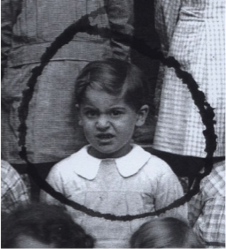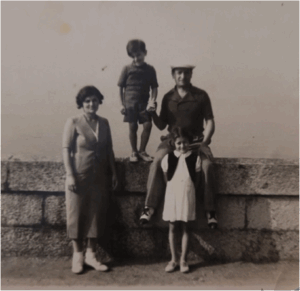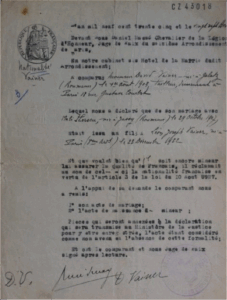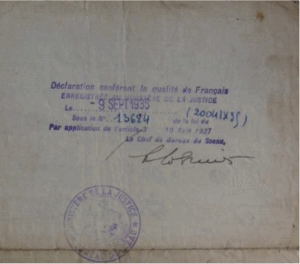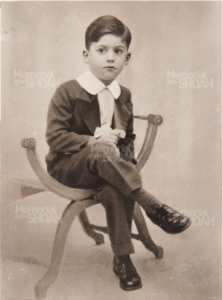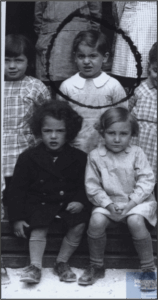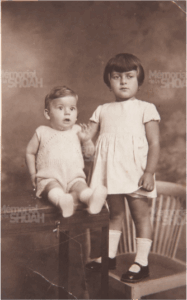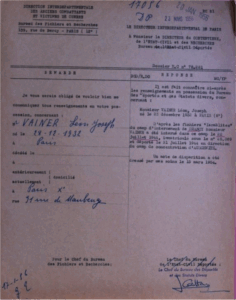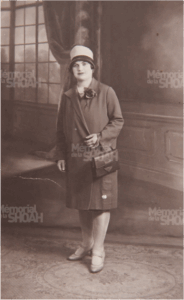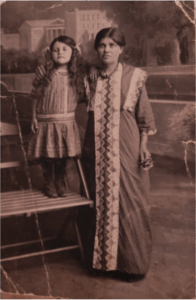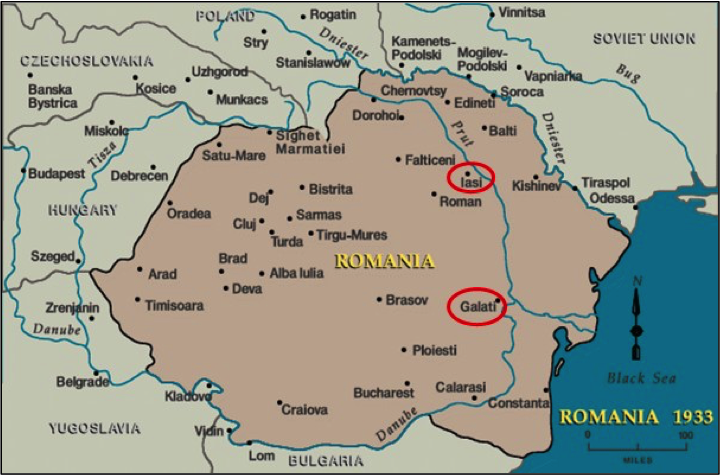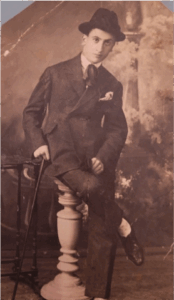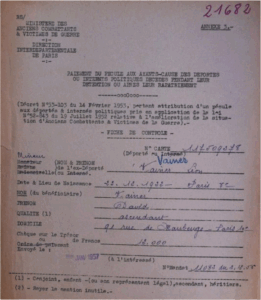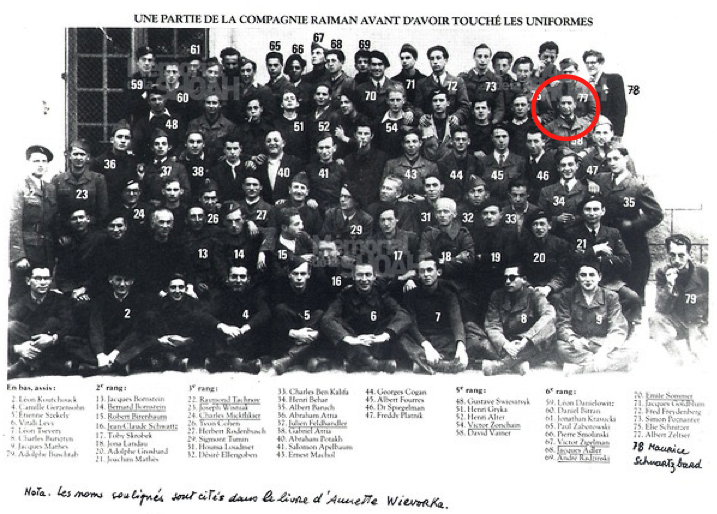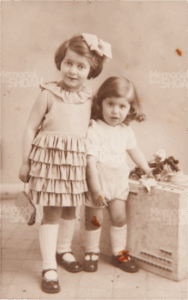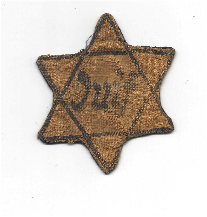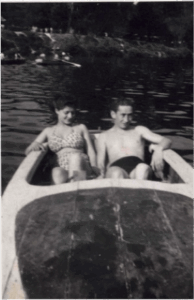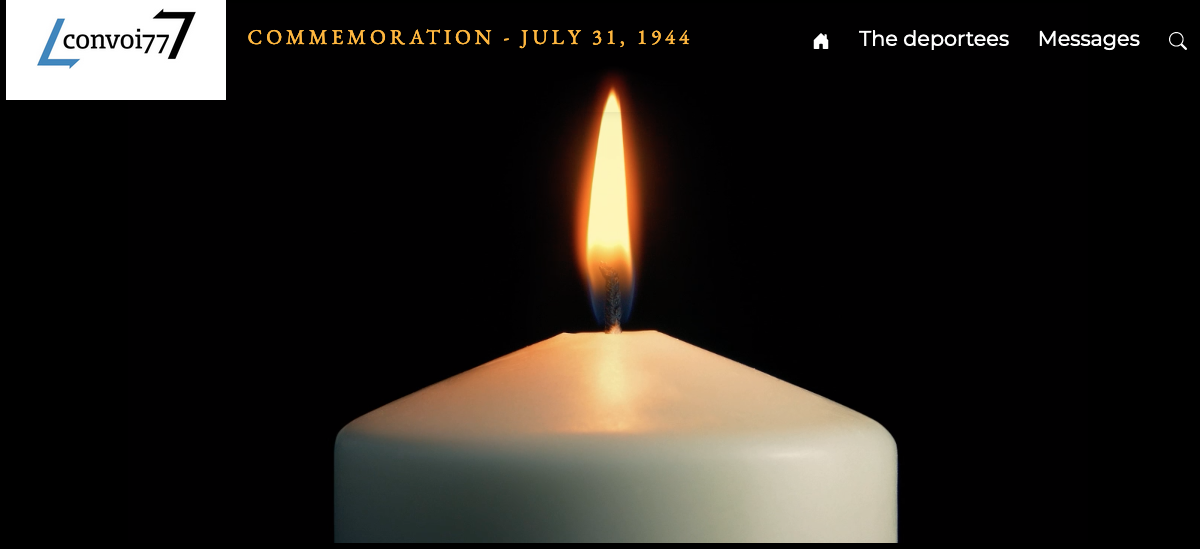Léon VAINER
This biography was written by a group of 9th grade students from the Victor Duruy secondary school in Châlons-en-Champagne, in the Marne department of France. As part of the “Convoy 77” project, it was a remembrance assignment that broadened the scope of their history and geography lessons.
We would like to thank Mr. Charlie Kohn and his sisters, Hélène and Martine for their help and the documentation they sent us.
Léna Carbain, Azilis Chafsey and Martin Renollet,
led by their history and geography teacher, Cécile Boudes
Léon Vainer
The Vainer family was made up of David Vainer, the father, Mali Herscu, the mother, and Anna and Léon Vainer, the children. Both parents were Romanian Jews. They met in France and had two children: Anna, who was born in 1929, and Léon, born in 1932. Mali was arrested first in 1942, followed by Léon in July 1944. Both were murdered in Auschwitz.
Photo of the Vainer family
Source: Anna Kohn’s family archives
Léon Vainer was born on December 23, 1932, in the 8th district of Paris. His parents, David Vainer and Mali Herscu, were both born in Romania.
Léon Vainer
Source: Serge Klarsfeld collection
Shoah Memorial, Paris
Léon was made a French citizen on September 9, 1935.
His father, David, made had made the necessary declaration for him to be granted French nationality on April 27, 1935 before a Justice of the Peace in the 16th district of Paris.
Declaration for Léon to become a French citizen
Victims of Contemporary Conflicts Archives Division of the French Ministry of Defense Historical Service, in Caen, dossier ref. 21-P-545-966
After his mother was arrested in 1942, Léon and his sister Anna, together with their father, went to stay with their aunt.
According to the family, Léon was a somewhat rebellious child, and did not cope at all well with being separated from his mother. This pre-war photo, which his sister Anna donated to the Shoah Memorial, was taken during a family celebration.
Photo of Léon passed on to the Shoah Memorial in Paris by Anna Kohn
Léon was then taken in by the O.S.E. (Organisation de secours aux enfants, or Children’s Aid Organization) and then the UGIF (Union Générale des Israélites de France, or General Union of French Jews). He was a boarder at the Lucien de Hirsch UGIF school on avenue Sécretan in Paris. We do not know when he arrived, there, or why. Between July 22 and 24, the Nazi commandant of Drancy camp, Aloïs Brunner, rounded up all of the children who were staying in the UGIF homes in and around Paris, including Léon. The Allied troops were advancing towards Paris, and Brunner was determined to deport as many Jews as possible, including these children, in the remaining time available.
Léon and the other children from the Lamarck-Secrétan UGIF home were then interned in the Drancy transit camp. When he arrived there on July 22, 1944, he was assigned the number 25,369. Along with 323 other children, he was deported to Auschwitz on Convoy 77 on July 31, 1944. The convoy arrived during the night of August 3-4 and, along with 835 of the 1306 people who had boarded the train at Bobigny station, Léon was most likely sent straight to the gas chambers and murdered,
Photo 1: Class photo of Léon
Photo 2: Photo of Léon and his sister, Anna, passed on to the Shoah Memorial in Paris by Anna Kohn
Request to the research department for information on Leon
Victims of Contemporary Conflicts Archives Division of the French Ministry of Defense Historical Service, in Caen, dossier ref. 21-P-545-966
The round up at the Secrétan children’s home
The roundup at the Lucien-de-Hirsch school, also known as the Lamarck-Sécretan center, at 70 avenue Secrétan in the 19th district of Paris took place during the night of July 21- 22 1944. The Lucien-de-Hirsch school, built in 1901, was the oldest Jewish school in Paris.
19 adults and 78 children, including Léon, were arrested that.
Léon was just one of the many victims who were deported on Convoy 77 to Auschwitz from Bobigny station, near Drancy camp in the north of Paris, on July 31, 1944.
Why were there so many children in the school that night?
When the Lamarck center, a UGIF children’s home on rue Lamarck in the 18th district of Paris, was bombed on April 20, 1944, the 125 children and 52 supervisors who were staying there were transferred to the Lucien-de-Hirsch school, which then became a UGIF home as well as a school.
During the night of July 21 to 22, the four other UGIF centers in and around Paris also fell victim to this mass, last-minute roundup: the ORT vocational school, Louveciennes, Saint-Mandé and Vauquelin.
In memory of all the people rounded up on avenue Secrétan, a granite slab was installed on the front wall of the Lucien-de-Hirsch building. The names of all the deported children and adults are on it, listed in alphabetical order.
There still remain a few grey areas: Was Léon taken in by the UGIF because his mother had been deported? Had Léon’s father, David, become involved in the Resistance and thus arranged for the UGIF to take him in? That could explain why he was at the school on the night of the roundup.
The story within the family is that David, Léon and Anna went to live in hiding with one of Mali’s sisters, or with another family, and that David, aware that the Normandy landings had taken place and that Paris would soon be liberated, felt that it was safe enough to send Léon back to school.
Anna is said to have told one of her daughters that it was she who took Léon to school that day. She was 15 at the time and went to secondary school elsewhere.
However, it is unlikely that classes were still being held on July 22, and the roundup took place on a Friday night. Perhaps Anna remembered taking her brother back there after spending a day with him, if he was staying there at the time?
Mali Herscu
Mali Herscu, Léon and Anna’s mother, was born on October 29, 1907 in Jassy in Romania. She emigrated to France in the early 1920s, and she met her husband David Vainer at a Jewish organization in Paris called the Juifs de Bessarabie. They got married on July 12, 1928 in the 18th district of Paris. Many of her relatives moved to France, as Romanians spoke French at the time. Like many other Romanian Jews, she was arrested on September 22, 1942, interned in Drancy camp and then deported to Auschwitz on Convoy 38.
Photo 1: Photo of Mali Herscu passed on to the Shoah Memorial in Paris by Anna Kohn
Photo 2: Mali and her mother in Romania. Source: Family archives
Convoy 38
On September 17, 1942, the German Ministry of Foreign Affairs in Berlin declared that from then on, following negotiations between the German and Romanian governments, Romanian Jews who lived in the Reich and in occupied countries could be deported. Prior to that, they had been exempt from deportation. It was no doubt as a result of this decision that the police went to arrest David and Mali at their apartment at 13 rue Courbet in the 16th district of Paris. David passed them on the staircase and managed to escape, but Mail was arrested
Convoy 38 left the Le Bourget station in Paris at 8:55 a.m. on September 28, 1942.
There were 904 Jews on board: 468 men and 436 women, 609 of whom were Romanian citizens: 282 men, 360 women (including Mali), 21 girls and 46 boys.
Of the 904 people deported on Convoy 38, only 20 men survived.
1,401 of the 1,574 Jews who had taken part in the census of Jews in France were deported on two convoys, numbers 37 and 38, in just three days.
A hundred men had already been selected for forced labor at Cosel before the convoy arrived. When it got to Auschwitz, a further 123 men were selected to go into the camp to work, and were tattooed with the numbers 66,515 to 66,637. Also selected for work were 48 women, who were tattooed with the numbers 21,116 to 21,163. The remaining deportees were sent straight to the gas chambers soon after the convoy arrived in the camp.
Source: Serge Klarsfeld, La Shoah en France, Fayard, 2001
Serge Klarsfeld, Le Mémorial de la déportation des Juifs de France, 1978
The Yad Vashem website: Transport 38 from Drancy camp to Auschwitz-Birkenau
Mali Herscu, Léon and Anna’s mother, was born on October 29, 1907 in Jassy (now Iași), the former capital of Romania.
Source : United States Holocaust Memorial Museum encyclopedia.ushmm.org
David Vainer
There is no official birth record for David Vainer (born Meyer Kohn), Léon and Anna’s father. It is thought that he was born after 1895.
He came from Galati in Romania. In order to avoid being drafted during the First World War, he assumed the identity of a dead man, David Vainer1. He emigrated to France and met his future wife, Mali, at a Jewish organization called the Juifs de Bessarabie. They got married on July 12, 1928 in the 18th district of Paris. His mother tongue was Romanian, but he also spoke Yiddish and, like many Romanians at the time, must have also spoken French. The family lived at 13, rue Gustave Courbet in the 16th district of Paris. David was a tailor who specialized in made-to-measure clothing.
David as a young man
Source: Family archives
The day his wife Mali was arrested, David only just managed to avoid being arrested as well. He passed the police on the stairs as he was on his way out, hid the yellow star sown onto his jacket and continued on his way. When the police came back for him a few days later, he jumped out of the window and escaped.
After Mali was arrested, David and the children went to live in hiding elsewhere, possibly with one of Mali’s sisters.
After the war, when he applied to have Mali and Léon officially declared missing, David was living at 91, rue de Maubeuge in the 10th district of Paris.
In 1953, David submitted an application for his son Léon to be granted “political deportee” status. He was notified that this had been approved on April 17, 1956 and Léon was officially declared a political deportee on May 22 of that year. In 1957, as the beneficiary of a political deportee or internee who died while in detention or after repatriation, he received a payment of 12,000 francs from the French Ministry of Veterans and Victims of War.
Record attesting the payment that David received as the beneficiary of a political deportee or internee who died while in detention or after repatriation
Victims of Contemporary Conflicts Archives Division of the French Ministry of Defense Historical Service, in Caen, dossier ref. 21-P-545-966
1 = According to his family
The Rayman company
On August 25, 1944, during the Liberation of Paris, a group of resistance fighters took over the Reuilly barracks, which until then had been used as a mobilization center for the French militia, and decided to found a Jewish Resistance group. They called it the Rayman Company.
Jacob Tancerman, who held the rank of lieutenant, acted as commander. A leaflet in Yiddish dated August 31, 1944, announced the formation of the Rayman company and appealed to young Jews in Paris to join its ranks in order to help end the war and liberate the rest of the country. David Vainer probably joined the company at this time, but we have no further information about this. He appears in the photo held by the Shoah Memorial at N°58. The Jewish company was called the “Marcel Rayman” company in tribute to a well-known figure among young Jewish resistance fighters, who was shot on February 21, 1944 at Mont-Valérien. Around 160 Jewish volunteers joined the company. Both French and foreign, most of them were aged between 15 and 18, and in most cases, their families had been deported. As for David, who was almost 50 years old, he was probably one of the oldest men in the company.
Source : museedelaresistanceenligne.org
Source: Shoah Memorial, Paris, ref. ML_A2_95
Anna Vainer
Anna Vainer, who was born on July 13, 1929, was the daughter of David and Mali Vainer née Herscu. After her mother was deported in 1942, she and her brother went to live in hiding with an aunt. Sadly, Léon was arrested and deported in 1944, but Anna managed to avoid deportation by hiding in a synagogue on rue Montévidéo1. She rebuilt her life after the war, but according to her children, the pain and horror she experienced at that time affected her badly. At first, she lived in hope that her mother and little brother would come home, but in the end, she had to come to terms with the sad reality of what had happened to them. All she had left were a few photos, which she entrusted to the Shoah Memorial in Paris, and which bear witness to her devotion to her brother.
Photo of Léon and his sister Anna, passed on to the Shoah Memorial in Paris by Anna Kohn
Anna Kohn’s yellow star
Source: Anna Kohn’s family
Her children recount how, for many years after the war ended, Anna kept her yellow star in a drawer, but she never felt able to wear any kind of identification label, even at vacation clubs for example. It reminded her of the yellow star, the Star of David, which all Jews were obliged to wear as of May 1942.
Photo of Anna and Chanina Kohn
Source: Anna Kohn’s family
Anna married a man called Chanina Kohn and they went on to have three children: Hélène, Martine and Charlie. However, Anna never really spoke to them about her wartime memories: it was just too painful.
Anna died on March 24, 2019 in Limeil-Brévannes, in the Val-de-Marne department of France.


 Français
Français Polski
Polski